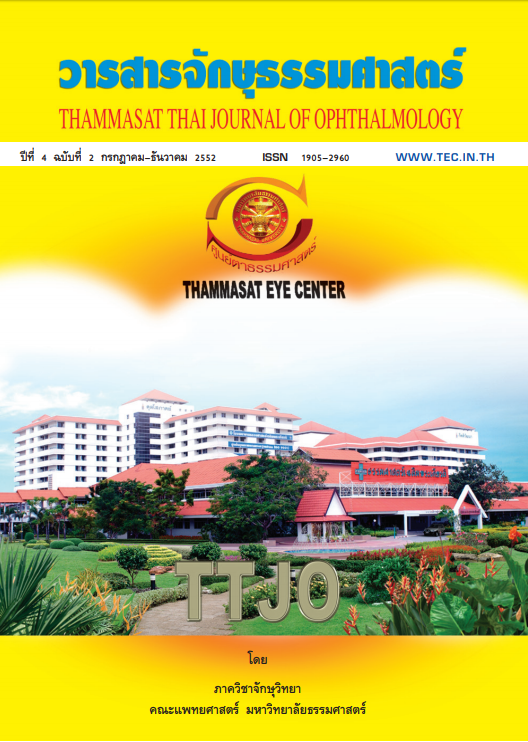Comparing of Bare Sclera Technique, Pedunculated Conjunctival Sliding Flap and Conjunctival Autografting Transplantation for Primary Pterygium Treatments
Main Article Content
Abstract
Purpose: To compare one-year follow-up results of primary pterygium surgery including bare sclera technique (BST), pedunculated conjunctival sliding flap (PCSF), and conjunctival autografting transplantation (CAT).
Design: Prospective randomized controlled study
Methods: This study is designed to compare three currently techniques for pterygium excision, in order to determine the complication and recurrence rates after grade III primary pterygium excision. There were 263 eyes of 263 patients included in this study. All treated eyes were randomized to undergo bare sclera technique (group A: BST) 85 eyes, pedunculated conjunctival sliding flap (group B: PCSF) 90 eyes, or conjunctival autografting transplantation (group C: CAT) 88 eyes. All patients were treated by a single surgeon and followed up for a period of at least one year.
Results: Sixteen recurrences (18.83%) were observed in group A (BST) whereas two recurrences (2.22%) were detected in group B (PCSF), and only one recurrence (1.14%) was noted in the last group C (CAT). There were no major complications threatening visual ability, reported in the treated patients.
Conclusions: BST was found to be a less effective procedure than PSCF and CAT, with more recurrence rates after primary pterygium excision. PCSF and CAT seem to be a useful treatment in primary pterygium surgery due to their safety and effectiveness in preventing recurrences without development of significant complications.
การเปรียบเทียบผลของการผ่าตัดต้อเนื้อที่เป็นครั้งแรกโดยวิธีการผ่าตัดแบบธรรมดา, วิธีการผ่าตัดโยกเยื่อบุตามาเย็บเสริมและวิธีการผ่าตัดแบบใช้เยื่อบุตาเลาะมาเย็บเสริม
วัตถุประสงค์: เพื่อการศึกษาเปรียบเทียบผลวิธีการผ่าตัดลอกต้อเนื้อที่เป็นครั้งแรกด้วย วิธี การผ่าตัดแบบธรรมดา Bare sclera (BST), วิธีการผ่าตัดโยกเยื่อบุตามาเย็บเสริม (Pedunculated conjunctival sliding flap: PCSF) และวิธีการผ่าตัดแบบใช้เยื่อบุตาเลาะมาเย็บเสริมในการลอกต้อเนื้อ (Conjunctival autografting transplantation: CAT)
ลักษณะการศึกษา: เป็นการศึกษาแบบ Prospective randomized case control study
วิธีการศึกษา: ทำการศึกษาเเพื่อเปรียบเทียบภาวะแทรกซ้อน และการเกิดเป็นซ้ำหลังผ่าตัดของวิธีการผ่าตัดลอกต้อเนื้อที่เป็นครั้ง แรกระดับ III ที่ทำในปัจจุบันทั้ง 3 วิธีโดยจักษุแพทย์คนเดียวที่ รพ.สวรรค์ประชารักษ์ โดยศึกษาในผู้ป่วยท้ังหมด 263 คน จำนวน 263 ตา โดยวิธีสุ่มแบ่งผู้ป่วยมารับการรักาาทั้ง 3 วิธีโดย มีผู้ป่วย 85 คน จำนวน 85 ตา ในกลุ่มแรก (BST), ผู้ป่วย 90 คน จำนวน 90 ตา ในกลุ่มที่สอง (PCSF) และกลุ่มที่สามมีผู้ป่วย 88 คน จำนวน 88 ตาที่ได้รับการผ่าตัดแบบ CAT ผู้ป่วยทั้งหมดได้รับการติดตามผลของการผ่าตัดอย่างน้อยเป็นเวลา 1 ปี
ผลการศึกษา: พบจำนวนการเกิดเป็นซ้ำหลังผ่าตัดจำนวน 16 ราย (18.83%) ในกลุ่มแรก (BST) และพบจำนวนผู้ป่วยที่เกิดเป็นซ้ำ 2 ราย (2.22%) ในกลุ่มที่สอง (PSCF) และสำหรับวิธีที่สาม (CAT) พบการกลับมาเป็นซ้ำหลังผ่าตัดเพียงรายเดียวเท่านั้น (1.14%) โดยในการศึกษาครั้งนี้ ไม่มีรายงานภาวะแทรกซ้อนที่เป็นอันตรายต่อการมองเห็นของผู้ป่วยหลังการผ่า ตัดลอกต้อเนื้อทุกรายไม่ว่าวิธีใดก็ตาม
สรุป: การผ่าตัดลอกต้อเนื้อวิธี BST มีประสิทธิภาพต่ำกว่าในการป้องกันการเกิดเป็นซ้ำหลังการผ่าตัดลอกต้อ เนื้อที่เป็นครั้งแรก และวิธีการผ่าตัดลอกต้อเนื้อ PCSF หรือ CAT โดยมีประสิทธิภาพสามารถป้องกันการกลับมาเป็นซ้ำของโรคต้อเนื้อได้ และมีความปลอดภัย โดยปราศจากภาวะแทรกซ้อนที่สำคัญหลังการผ่าตัด
Article Details
References
Cameron ME. Histology of pterygium: an electron microscopic study. Br J Ophthalmol 1983; 67:604-8.
Lewallen S. A randomized trial of conjunctival autografting for pterygium in the tropics. Ophthalmology 1989;96:1612-4.
Tasman W, Jaeger EA. Duaneûs Clinical Ophthalmology. Vol.6. Philadelphia, PA: Lippincott Williams and Wilkins, 2002:35.
Tan DTH, Lim ASM, Goh H, Smith DR. Abnormal expression of the p53 tumor suppressor gene in the conjunctiva of patients with pterygium. Am J Ophthalmol 1997; 123:404-5.
Dushku N, Reid TW. P53 expression in altered limbal basal cells of pingueculae, pterygia, and limbal tumors. Curr Eye Res 1997; 16:1179-92.
Saw SM, Tan D. Pterygium: prevalence, demography and risk factors. Ophthalmic Epidemiol 1999;6(3):219-28.
Tan DT, Chee SP, Dear KB, Lim AS. Effect of pterygium morphology on pterygium recurrence in a controlled trial compairing conjunctival autografting with bare sclera excision. Arch Ophthalmol 1997;115(10): 1235-40.
Rohrbach IM, Starc S, Knorr M. [predicting recurrent pterygium based on morphologic and immunohistologic parameters] Ophthalmology 1995;92(4):463-8.
Maheshwari S. Pterygium induced-corneal refractive changes. Indian J Ophthalmol 2007; 55:383-6.
Kitnarong N, Suvatte N, Sakiyaluksana D, Thammataksin S. Surgery for Primary Pterygium Using a Pedunculated Conjunctival Sliding Flap Technique Compare to Bare Sclera Technique. Thai J Ophthalmol 2004; 18(2):141-6.
Chaidaroon W, Wattananikorn S. Conjunctival autograft transplantation for primary pterygium. J Med Assoc Thai 2003;86(2):111-5.
Al Fayez MF. Limbal versus conjunctival autograft transplantation for advanced and recurrent pterygium. Ophthalmology 2002; 109:1752-5.
Donnenfeld ED, Perry HD, Fromer S, et al. Subconjunctival mitomycin C as adjunctive therapy before pterygium excision. Ophthalmology 2003;110:1012-6.
Mutlu FM, Sobaci G, Tatar T, et al. A Comparative Study of Recurrent Pterygium Surgery. Ophthalmology 1999;106:817-21.
Duke-Elder SS. ed. Degenerative and pigmentary changes. In: System of ophthalmology. 3rd ed. London: Henry Kimpton, 1977:569-85.
Jaros PA, Deluise VP. Pingueculae and pterygia. Surv Ophthalmol 1988;33:41-9.
Adamis AP, Starck T, Kenyon KR. The management of pterygium. Ophthalmol Clin North Am 1990;3:611-23.
Hilgers JHC. Pteygium: incidence, heredity and etiology. Am J Ophthalmol 1960;50:635-44.
Mackenzie FD, Hirst LW, Battistutta D, et al. Risk analysis in the development of pterygia. Ophthalmology 1992;99:1056-61.
Luanratanakorn P, Ratanapakorn T, Suwanapichon O, Chuck RS. Randomised controlled study of conjunctival autograft versus amniotic membrane graft in pterygium excision. Br J Ophthalmol 2006;90(12):1476-80.
Tananuvat N, Martin T. The results of amniotic membrane transplantation for primary pteygium compared with conjunctival autograft. Cornea 2004;23:458-63.
Riordan-Eva P, Kielhorn I, Ficker LA, et al. Conjunctival autografting in the surgical management of pterygium. Eye 1993;7(Pt5): 634-8.
Tekin NF, Kaynak S, Saatci AO, Cingil G. Preserved human amniotic membrane transplantation in the treatment of primary pterygium. Ophthalmic Surg Lasers 2001; 32(6):464-9.
Lei G. Surgery for pterygium using a conjunctival pedunculated flap slide. Br J Ophthalmol 1996;80(1):33-4.
Tomas T. Sliding flap of conjunctival limbus to prevent recurrence of pterygium. Refract Corneal Surg 1992;8(5):394-5.
McCoombes JA, Hirst LW, Isbell GP. Sliding conjunctival flap for the treatment of primary pterygium. Ophthalmology 1994;101(1): 169-73.
Kenyon KR, Wagoner MR, Hettinger ME. Conjunctival autograft transplantation for advanced and recurrent pterygium. Ophthalmology 1985;92:1461-70.
Soliman Mahdy MA, Bhatia J. Treatment of primary pterygium: role of limbal stem cells and conjunctival autograft transplantation. Eur J Ophthalmol 2009;19(5):729-32.


